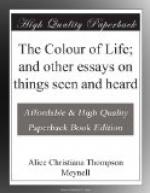This is the train of thought that followed the grey figure of a woman on a bicycle in Oxford Street. She had an enormous and top-heavy omnibus at her back. All the things on the near side of the street—the things going her way—were going at different paces, in two streams, overtaking and being overtaken. The tributary streets shot omnibuses and carriages, cabs and carts—some to go her own way, some with an impetus that carried them curving into the other current, and other some making a straight line right across Oxford Street into the street opposite. Besides all the unequal movement, there were the stoppings. It was a delicate tangle to keep from knotting. The nerves of the mouths of horses bore the whole charge and answered it, as they do every day.
The woman in grey, quite alone, was immediately dependent on no nerves but her own, which almost made her machine sensitive. But this alertness was joined to such perfect composure as no flutter of a moment disturbed. There was the steadiness of sleep, and a vigilance more than that of an ordinary waking.
At the same time, the woman was doing what nothing in her youth could well have prepared her for. She must have passed a childhood unlike the ordinary girl’s childhood, if her steadiness or her alertness had ever been educated, if she had been rebuked for cowardice, for the egoistic distrust of general rules, or for claims of exceptional chances. Yet here she was, trusting not only herself but a multitude of other people; taking her equal risk; giving a watchful confidence to averages—that last, perhaps, her strangest and greatest success.
No exceptions were hers, no appeals, and no forewarnings. She evidently had not in her mind a single phrase, familiar to women, made to express no confidence except in accidents, and to proclaim a prudent foresight of the less probable event. No woman could ride a bicycle along Oxford Street with any such baggage as that about her.
The woman in grey had a watchful confidence not only in a multitude of men but in a multitude of things. And it is very hard for any untrained human being to practise confidence in things in motion—things full of force, and, what is worse, of forces. Moreover, there is a supreme difficulty for a mind accustomed to search timorously for some little place of insignificant rest on any accessible point of stable equilibrium; and that is the difficulty of holding itself nimbly secure in an equilibrium that is unstable. Who can deny that women are generally used to look about for the little stationary repose just described? Whether in intellectual or in spiritual things, they do not often live without it.
She, none the less, fled upon unstable equilibrium, escaped upon it, depended upon it, trusted it, was ’ware of it, was on guard against it, as she sped amid her crowd her own unstable equilibrium, her machine’s, that of the judgment, the temper, the skill, the perception, the strength of men and horses.




